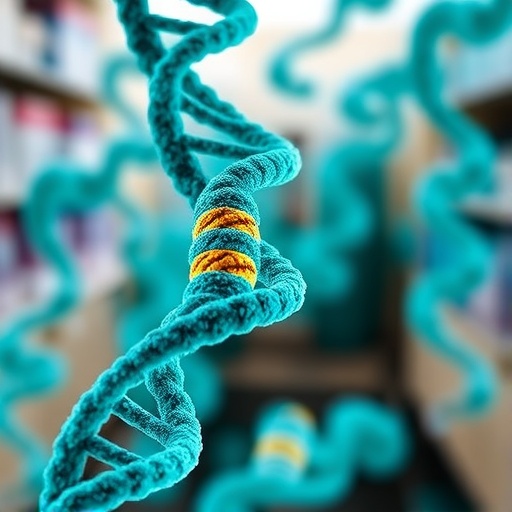In a groundbreaking study published in the prestigious journal Nature, researchers at Mayo Clinic have uncovered a pivotal protein that coordinates critical cellular processes during DNA replication, dramatically advancing our understanding of genomic stability and opening promising avenues for cancer therapy development. This protein, known as KCTD10, acts much like a molecular traffic controller, preventing catastrophic collisions between the cellular machinery responsible for copying DNA and that responsible for reading it to produce RNA, processes essential for life.
Cell division is one of the most fundamental biological events, requiring the accurate and faithful duplication of DNA so that each daughter cell inherits an intact genetic blueprint. This DNA replication process is managed by specialized molecular complexes that move along the DNA strands rapidly and with high precision. Meanwhile, the transcription machinery traverses the same DNA strands to decode genetic information into RNA, which then guides protein synthesis. Importantly, these two complexes operate on the very same DNA template, creating inevitable risks of collision.
KCTD10’s role is critical because DNA replication machinery progresses at a faster rate than transcription machinery, raising the potential for harmful encounters that can induce DNA breaks or genomic instability—a hallmark of cancerous cells. Prior to this discovery, biologists had little insight into how cells detect and resolve such conflicts efficiently to preserve genomic integrity during cell division.
The Mayo Clinic research team discovered that KCTD10 functions as a sensor that detects imminent collisions between the replication and transcription machines on DNA. Upon sensing trouble, KCTD10 activates an enzyme called CUL3, which executes a targeted ubiquitination process. This process selectively tags proteins that impede the swift passage of the replication machinery, marking them for removal. By clearing the transcription machinery ahead, KCTD10 prevents DNA damage, allowing replication to proceed smoothly.
Ubiquitination, in this context, operates as a molecular signaling mechanism that orchestrates the controlled degradation or repositioning of proteins obstructing the DNA replication pathway. The interplay between KCTD10 and CUL3 exemplifies a sophisticated cellular defense strategy to maintain genome integrity by ensuring precise coordination between replication and transcription activities.
Interestingly, the research highlights that the co-directional orientation of replication and transcription machinery—which run in the same direction on DNA—may not be a random evolutionary artifact but rather an organizational strategy shaped by the functions of proteins like KCTD10. This implies a broader significance of KCTD10 in structuring the human genome’s architecture to minimize conflict-induced DNA damage.
Beyond its fundamental biological importance, KCTD10’s activity—or lack thereof—has profound implications for cancer biology. Absence or malfunction of KCTD10 has been linked to genomic instability, fostering mutations that promote tumorigenesis. Additionally, clinical observations have associated developmental delays with KCTD10 deficiency, underscoring its vital role beyond cancer.
Remarkably, the very vulnerability caused by the loss of KCTD10 in cancer cells could be exploited for therapeutic interventions. Cancer cells deficient in this protective mechanism become particularly susceptible to DNA damage and stress, presenting a unique “Achilles’ heel” that targeted treatments could attack selectively, sparing healthy cells.
This insight offers a new therapeutic window to develop cancer treatments that push vulnerable tumor cells beyond their capacity to cope with DNA damage, tipping them towards programmed cell death. Identifying cancers deficient in KCTD10 expression and understanding the molecular pathways affected provide a strategic focus for drug development.
Jake Kloeber, a dual M.D.-Ph.D. student and co-lead author of the study, emphasizes that decoding these underlying molecular processes in normal and cancerous cells could revolutionize precision oncology. His work exemplifies the synergy between clinical medicine and biomedical research, aiming to translate molecular discoveries into impactful cancer therapies.
The Mayo Clinic has embedded this research within its larger Precure initiative, an ambitious program seeking to create predictive and interceptive tools capable of diagnosing and managing diseases at their earliest, most manageable phases. The study’s outcomes are expected to contribute valuable biomarkers and therapeutic targets as part of this vision.
The detailed mechanistic insights into how KCTD10 senses transcription-replication conflicts and mediates genome protection deepen our molecular grasp of cell division fidelity. These findings highlight the complexity and elegance of intracellular coordination essential for life and reinforce the importance of tightly regulated protein networks in genomic maintenance.
As research on KCTD10 continues, efforts will focus on elucidating the prevalence of KCTD10 deficiency across various cancer types and screening for drugs—either novel compounds or existing agents—that can selectively eradicate cancer cells exhibiting this weakness. This promising path may lead to breakthroughs in personalized cancer therapy, optimizing treatment efficacy and minimizing side effects.
In summary, Mayo Clinic’s identification of KCTD10 as a guardian protein coordinating DNA replication and transcription machinery offers profound insights into maintaining genome stability. It heralds a new frontier for cancer research where understanding molecular traffic control at the DNA level can be harnessed to devise innovative, targeted therapeutic strategies.
Subject of Research: The molecular mechanisms by which KCTD10 protein senses and resolves co-directional transcription-replication conflicts to maintain genomic integrity and its implications for cancer therapy.
Article Title: KCTD10 is a sensor for co-directional transcription–replication conflicts
News Publication Date: October 8, 2025
Web References:
Study published in Nature: https://www.nature.com/articles/s41586-025-09585-9
Mayo Clinic: https://www.mayoclinic.org/
References:
Lou, Z., Kloeber, J., et al. “KCTD10 is a sensor for co-directional transcription–replication conflicts.” Nature, 8 Oct 2025.
Keywords:
KCTD10, DNA replication, transcription, genomic stability, cancer therapy, ubiquitination, CUL3, genome integrity, co-directional conflicts, molecular traffic controller, protein sensor, tumorigenesis.
Tags: breakthroughs in cancer biologyCancer Treatment Targetscellular machinery interactionsDNA damage prevention strategiesDNA Replication Mechanismsgenomic integrity in cell divisiongenomic stability researchimplications for cancer therapy developmentKCTD10 protein functionMayo Clinic scientific researchmolecular traffic controller proteinsRNA transcription processes





